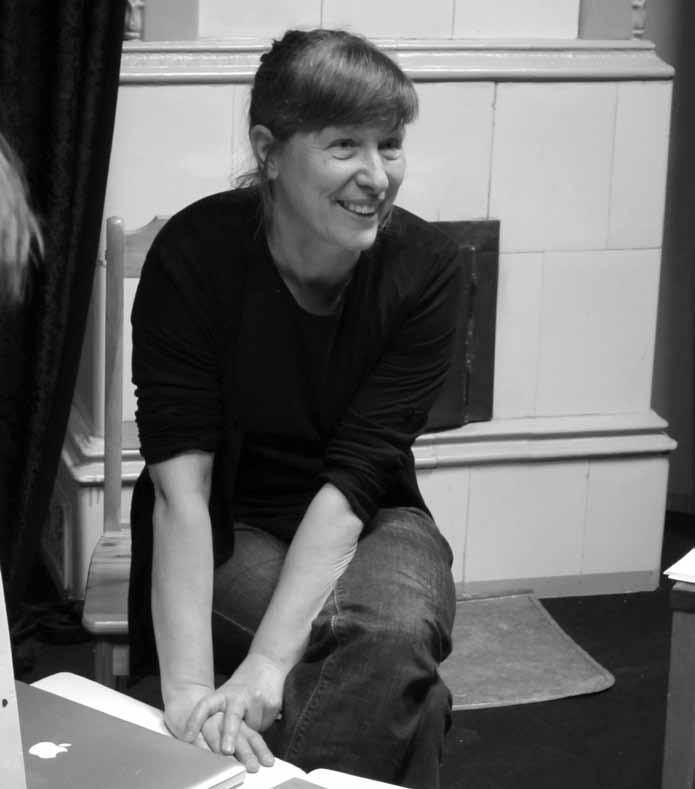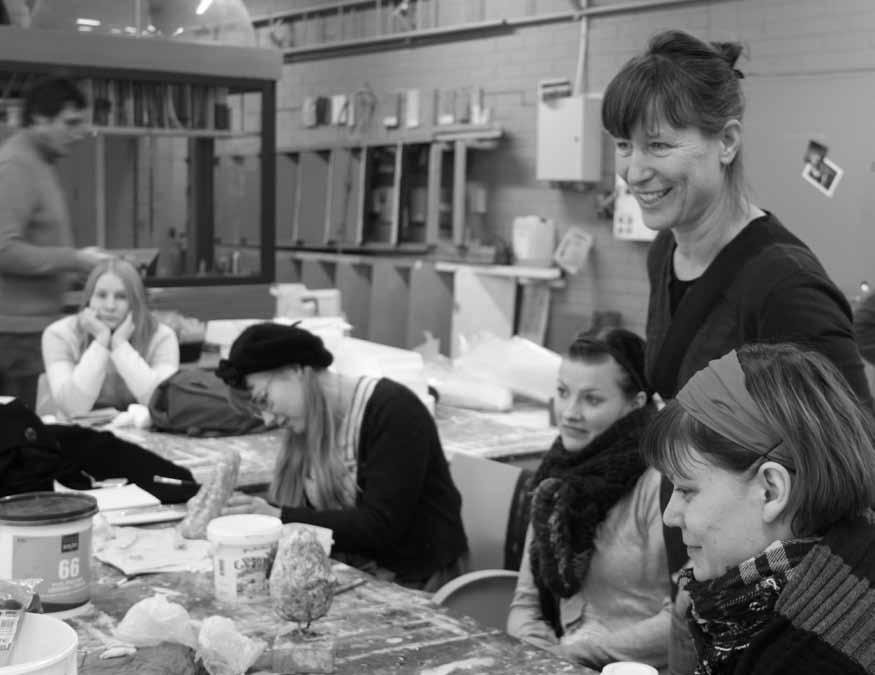
8 minute read
Rene Baker: Discover the puppet
photo: Malla Koivula
Morning warm-up. Rene Baker and student Mila Nirhamo.
Advertisement
Rene Baker has spent two years in Finland as a teacher of puppet theatre. What is on her mind after her period in Turku Arts Academy?
What were your first thoughts when you were asked to come to teach in Finland?
My first thought was that it will be a pleasure to teach in one place for a whole year after having spent the previous three years living out of a suitcase as an international freelance workshop leader. In the end I have been two years in Turku and I can see how my teaching has been positively influenced by the slow-cooking of weekly classes compared to the high-heat grill of intensive short courses.
What made you come?
I admire the work done by the teachers and students in the puppetry department of the Turku AMK. At international festivals the Turku students always stand out because of their personal expression and it is evident that they are people who care about puppetry as an art form. When I received the invitation to teach in Turku I had been working too long in acting schools, always fighting for puppet theatre to be recognised, and so it was appealing to come to a place where people actually want to be puppeteers.
What are the most important things you have to have to be a good teacher for adult people?
Teaching adults is a collaboration. I propose the exercises but each person brings their own experience and ideas to the work and sometimes – as happened with the 3rd year students last year – the classroom becomes more like a laboratory where we pose questions as a group and search for the answers together.
You have a long career as a teacher of puppetry. How could you characterize students in Finland?
Finnish students tend to be quiet, shy and even introverted because it is in the Finnish nature to be reserved in their physical expression but they are very free and happy expressing themselves through objects, colours, textures, images and music. Puppetry seems to suit the Finnish soul.
Compared to students in other countries? Before Turku I was teaching for many years in Spain. Spanish students have vitality and love to communicate but they usually need to learn to be sensitive to the material and to give focus to the puppet. Finns are the opposite – they have a good touch for bringing objects to life but they need to be en-
couraged to be more energetic and to develop a connection with the audience.
If possible could you describe your methods of teaching with few sentences? What are your main messages?
The core of the training is learning to listen to the material and to find the point between controlling and not controlling the puppet. The paradox of puppeteering is that a puppet can’t come alive without human intervention but if the human controls the object too much then it won’t live. I begin the training by encouraging people to discover the puppet – finding out how it moves naturally and how that movement can be interpreted - before teaching analysed movement such as impulse, rhythm and looking. Good puppeteering allows the puppet to come to life rather than makes it come to life – as Gordon Craig said “Don’t move it, let it move. That’s the art!”
What made you create these methods?
Contemporary trends in visual theatre mean puppeteers want (and are asked) to bring anything and everything to life – everyday objects, dolls, sticks, paper, clothes, parts of the human body, light – but there is no established technique for learning to animate a piece of paper or a raincoat. So when I was first asked to teach I decided to create a training for today’s puppeteers, with exercises that can be applied to any kind of puppet or object to bring it to life. Over ten years I have developed a set of puppeteering ‘tools’ – touch, breath, concentration, rhythm, impulse, and more – some of which train the body and mind of the puppeteer and others develop the puppet’s expressivity. It is my hope that mastering these tools will enable puppeteers to work with any kind of puppet, object or material, even the traditional techniques.
How do your methods fit in Finnish rhythm and soul?
I think it suits Finnish puppeteers because they can concentrate on one tool at a time and develop at their own pace. The beginning of the training is exploratory and intuitive, and because it focusses on what the puppet is doing rather than what the puppeteer does the student gains confidence and skill without feeling they are in the spotlight. One of my directing tips is to give instructions directly to the puppet and not the puppeteer – for example, “puppet, please stand up straight. Your knees are still bent. That’s better” - and I’ve noticed that it is particularly helpful when working with Finnish puppeteers.

What has happened amongst students during this period (two years)?
In our first manipulation class, the first year students came to the warm-up circle wrapped in shawls and cardigans, hidden under layers of clothing, but they eventually emerged to become confident and playful. In their second year they have chosen to challenge themselves in their art – a harmony-lover decided to explore evil, a timid body became a leather-clad rockstar, a loner chose a three-person manipulation project - and I could cite a similar example of courage for every single student. They all still wear woollen socks though.
What has been your role in this development? What have you given to students?
During our various goodbyes, more than one student thanked me for creating a safe environment for them to grow. They said they had felt seen and heard, that I was aware of their process, and that I had given everyone a voice. They also seem confident about having real tools for animating puppets and objects and are looking forward to using them when they make their own work next year.
Have your own ideas and thoughts about puppetry changed during your stay in Finland?
I have confirmed and polished my ideas rather than changed them. These two years in Finland has given me the opportunity and space to reflect on what I like to see in puppeteers and puppetry and the long winer evenings gave me the push to write it all down. When the book is published it will be thanks to my students and colleagues in the puppetry department of the Turku AMK and the lonely Finnish nights.
Tell some highlights during these years?
Working with the puppetry students has been such a constant joy that it is hard to say what are the highlights. Maybe it is to have witnessed some remarkable changes in people, for example someone who began two years ago with low self-esteem and has grown to have a strong stage presence. I’ve also enjoyed taking puppetry-thinking into other disciplines, such as teaching visual dramaturgy to circus students and working on space and composition with the theatre students.
photo: Malla Koivula

Rene in the workhop ”Muikkula”. Students Annikki Levomaa, Emma Golnick and Jenni Helenius.
Have you had any total mistakes in teaching (something has not worked at all, totally unlucky experience etc.)? Would you do something other way?
Some years ago I learned that listening to the puppet can’t be the only thing in a course. One group had difficulties improvising by perceiving what the puppets want to do, and the more I tried to make them feel the material, the less creative they became. It was probably the least playful course about playing I have ever done and eventually everyone got completely blocked. I learned that improvisation must lead to something concrete and to balance intuitive play with analysed tasks.
A short analyse about Finnish puppetry or puppetry you have seen here in Finland?
For the last ten years my experience of Finnish puppetry has been in the Turku puppetry community, which consists mostly of exstudents of the AMK, so I don’t feel I have enough perspective to be able to talk about Finnish puppetry in general.
What kind of message you would like to send to Turku puppetry community?
Be confident that you have something to offer nationally and internationally. Turku may be your puppetry home but take your work further afield, ask for grants, apply for festivals, travel the world. Don’t be shy.
Word assosiation
What comes first on your mind?
Winter: Snow. Breathing. Beauty.Peace Forest: Completion. Linnankatu 54: my second home Home: where I hang my coat Rovaniemi: creative wooden house Friends: scattered, in touch Spain: 13 years life chapter, memories Detail: essential, precision Garden: passion, nurture Aurajoki: flowing brown, frozen white
What have been your feelings about living in a city like Turku?
I have lived in the centre of Turku and enjoy walking everywhere. I love the river, the föri, the flea markets but I haven’t really got to know the city from the inside, I didn’t have a social life here.
What will you miss here?
Rye bread, rahka, lingon berries, wooden houses, sauna, the river. The puppetry community.
Will you come back?
Yes, I will be teaching some short courses at the AMK again in the autum but as a visiting teacher rather than as regular part-time teacher who is living in Turku. And I will definitely come to the 2014 Fanatik Figuras festival to see the graduation works of the students I have been teaching for the past two years. It will be so interesting to see how they have grown as artists.
What will you do next?
I have been teaching for 15 years but now I’d like to return to the theatre world and set up my own theatre company. Also, after 15 years of living abroad (Spain and Finland) I have decided to live in England again so that I can be close to my parents as they get older.










